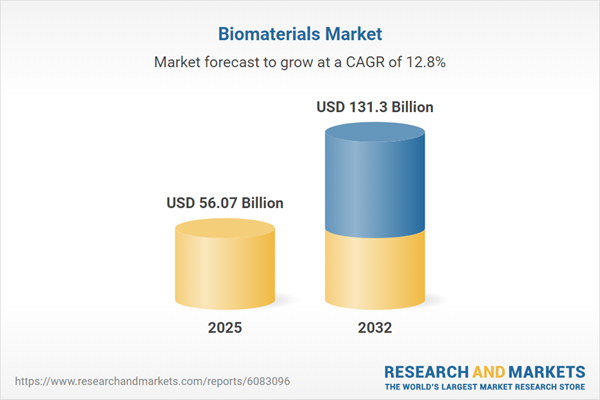Speak directly to the analyst to clarify any post sales queries you may have.
The biomaterials market is undergoing rapid evolution, driven by technological advancements, changing clinical needs, and regulatory developments. Senior executives are increasingly challenged to adopt agile strategies that support innovation, expedite commercialization, and manage new market complexities.
Market Snapshot: Biomaterials Market Size and Future Trends
The global biomaterials market expanded from USD 49.94 billion in 2024 to USD 56.07 billion in 2025 and is forecast to progress at a CAGR of 12.84%, reaching USD 131.30 billion by 2032. Industry growth is underpinned by expanding applications in regenerative medicine and cutting-edge advancements in materials science. Demand is intensifying for biomaterials within tissue engineering, medical device manufacturing, and wider medical uses, particularly as healthcare systems worldwide seek more effective and sustainable solutions. This market momentum is reinforced by healthcare providers prioritizing advanced therapies and governments supporting innovation initiatives.
Scope & Segmentation: Comprehensive Industry Coverage
- Material Types: Includes ceramics such as alumina, bioglass, hydroxyapatite, and zirconia, along with an array of metallic and natural substances, as well as synthetic polymers like PCL, PGA, PLA, PLGA, polyethylene, polypropylene, polyurethane, and polyvinyl alcohol.
- Classification: Covers bioactive, biocompatible, and bioinert materials, supporting a wide spectrum of clinical and performance requirements across the sector.
- End Users: Biotechnology companies, hospitals, research laboratories, and specialty clinics, each influencing procurement policies and innovation agendas in distinct ways.
- Applications: Encompasses cardiovascular (guidewires, stents, implantable devices, vascular grafts), dental (bone grafts, implants, membranes, tissue regeneration), ophthalmology, orthopedics (tissue fixation, joint replacement, orthobiologics, spine, viscosupplementation), urinary applications, and wound healing (adhesion barriers, fracture healing, tissue sealants, skin substitutes, surgical hemostats).
- Geographical Coverage: Markets span the Americas (US, Canada, Mexico, Brazil, Argentina, Chile, Colombia, Peru), Europe, Middle East & Africa (UK, Germany, France, Russia, Italy, Spain, Netherlands, Sweden, Poland, Switzerland, UAE, Saudi Arabia, Qatar, Turkey, Israel, South Africa, Nigeria, Egypt, Kenya), and Asia-Pacific (China, India, Japan, Australia, South Korea, Indonesia, Thailand, Malaysia, Singapore, Taiwan).
- Leading Players: Key participants include Aroa Biosurgery, BASF SE, Berkeley Advanced Biomaterials, Bezwada Biomedical, Carpenter Technology, Celanese, CoorsTek, Corbion, Covestro, Dentsply Sirona, DSM-Firmenich, Evonik Industries, Exactech, Heraeus Holding, Invibio, Medtronic, Modern Meadow, MycoWorks, Noble Biomaterials, Smith & Nephew, Stryker, and TissueForm.
Key Takeaways: Strategic Insights for Biomaterials Stakeholders
- Advanced manufacturing methods, including 3D printing and computational modeling, enable greater product customization and functional optimization, strengthening product pipelines.
- Stakeholders operate within a challenging regulatory climate, emphasizing early compliance planning and strategic engagement with reimbursement systems to maintain viability.
- Innovation in bioresorbable polymers and upcycled materials aligns product strategies with sustainability goals while addressing shifting clinical demands across medical settings.
- Collaboration among universities, research centers, and industry partners is accelerating development cycles and expediting time-to-market for next-generation solutions.
- Intellectual property portfolios, along with digital integration into new biomaterial products, have become critical in securing differentiation and supporting expansion strategies.
Tariff Impact: Addressing New Challenges in the U.S. Market
The introduction of U.S. tariffs in 2025 on vital biomaterial inputs is prompting companies to re-evaluate their supply chains and pivot toward nearshoring. Domestic sourcing, value engineering, and solidifying relationships with regional suppliers have become central to maintaining efficiency and managing risk. Proactive scenario planning for tariff-related disruptions now forms a routine part of operational continuity strategies across the U.S. biomaterials landscape.
Methodology & Data Sources
This analysis is built on comprehensive secondary research, interviews with industry experts, and enhanced data analytics. Findings are validated through triangulation of primary and secondary sources to ensure reliability and actionable insight for executive decision-making.
Why This Report Matters: Outcomes and Strategic Value
- Empowers decision-makers to refine innovation and R&D investments, aligning with regulatory shifts and evolving market trends for accelerated access and reduced risk.
- Offers guidance on optimizing procurement processes, improving supply chain agility, and leveraging partnerships for sustained development within the biomaterials ecosystem.
- Delivers competitive and segment-level insights that support resource prioritization, product portfolio optimization, and long-term investment planning.
Conclusion
Leading organizations in the biomaterials sector are advancing through integrated technology adoption, material innovation, and fresh collaborations. Those embracing these trends are positioned to drive growth and support ongoing advancement in healthcare solutions.
Table of Contents
3. Executive Summary
4. Market Overview
7. Cumulative Impact of Artificial Intelligence 2025
List of Figures
Companies Mentioned
The companies profiled in this Biomaterials market report include:- Aroa Biosurgery Limited
- BASF SE
- Berkeley Advanced Biomaterials Inc.
- Bezwada Biomedical, LLC
- Carpenter Technology Corporation
- Celanese Corporation
- CoorsTek, Inc.
- Corbion N.V.
- Covestro AG
- Dentsply Sirona Inc.
- DSM-Firmenich AG
- Evonik Industries AG
- Exactech, Inc.
- Heraeus Holding GmbH
- Invibio Limited
- Medtronic PLC
- Modern Meadow, Inc.
- MycoWorks, Inc.
- Noble Biomaterials, Inc.
- Smith & Nephew PLC
- Stryker Corporation
- TissueForm, Inc.
Table Information
| Report Attribute | Details |
|---|---|
| No. of Pages | 184 |
| Published | November 2025 |
| Forecast Period | 2025 - 2032 |
| Estimated Market Value ( USD | $ 56.07 Billion |
| Forecasted Market Value ( USD | $ 131.3 Billion |
| Compound Annual Growth Rate | 12.8% |
| Regions Covered | Global |
| No. of Companies Mentioned | 23 |









